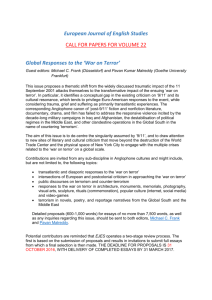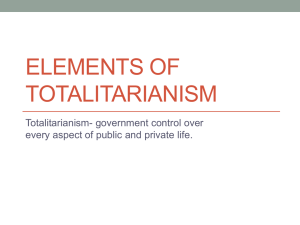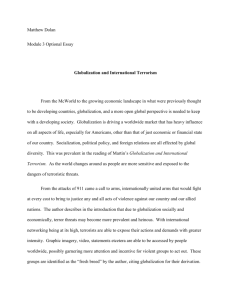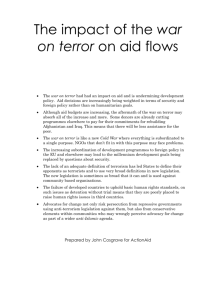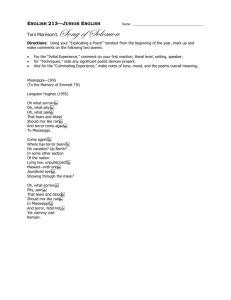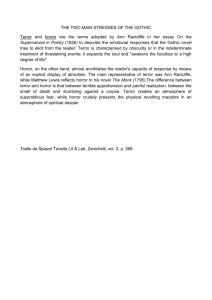Effect of Attack's Severity on Stock Prices
advertisement
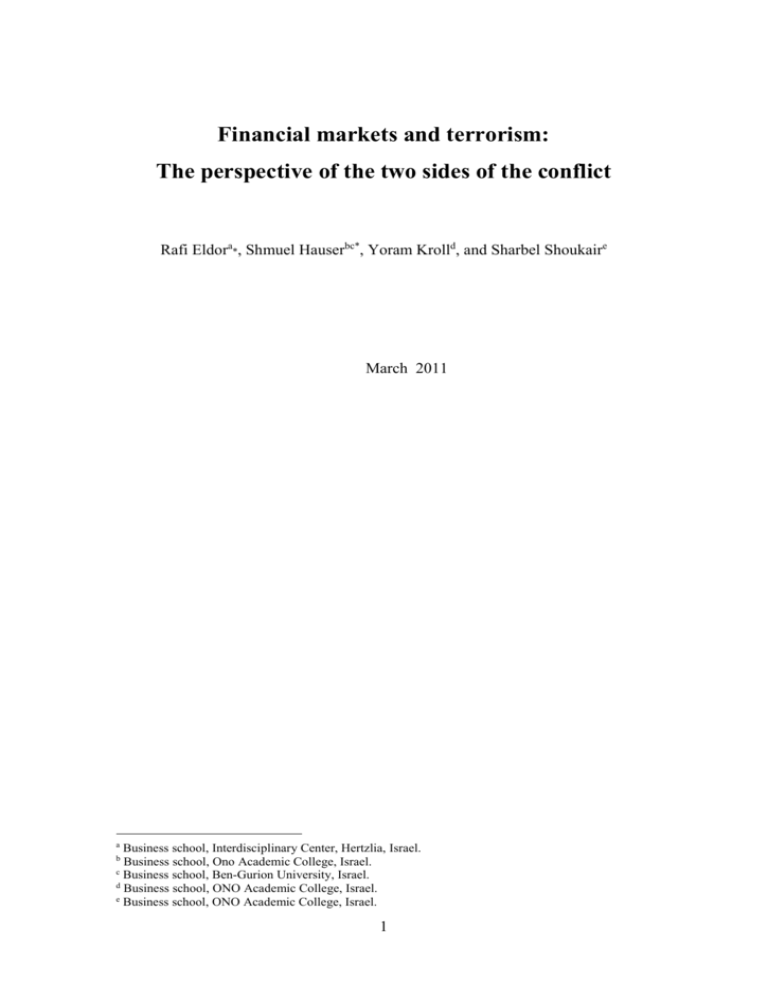
Financial markets and terrorism: The perspective of the two sides of the conflict Rafi Eldora*, Shmuel Hauserbc*, Yoram Krolld, and Sharbel Shoukaire March 2011 a Business school, Interdisciplinary Center, Hertzlia, Israel. Business school, Ono Academic College, Israel. c Business school, Ben-Gurion University, Israel. d Business school, ONO Academic College, Israel. e Business school, ONO Academic College, Israel. b 1 Abstract This paper uses a unique data set to examine the effect of terrorism on financial markets of both sides of the barricade in the Israeli-Palestinian conflict. The main finding are: (1) Real economy suffered during the intifada period and share prices declined significantly in both markets; (2) There is a bi-directional causality effects of returns in the two markets and both markets are affected by the US market; (3) Share prices declined in both markets following a terror attack. The more fatal the terror attack is, the greater is the negative effect in the two markets. In the more severe terror attack event (i.e. more people were killed and injured or if it was suicide attack), share prices in the Israeli market declined significantly by 0.63% compared to a decline of 0.16% in less severe attacks. The same pattern is revealed on the Palestinian side. In the more severe terror attack, share prices declined significantly by 0.21% compared with 0.07% in less severe attacks. JEL classifications: G10; G14 Keywords: Terror attack; Terrorism; Stock markets; September 11 2 1. Introduction In recent years a number of studies documented that terror attacks adversely affect the expectations of firms’ profitability causing share prices to decline and predicting a slow down in economic activity1,2. Abadie and Gardeazabal (2003) found that terrorism reduced per capita GDP in the Basque Country by some 10 percent while Eckstein and Tsiddon (2004) estimated a 5 percent decline in GDP for Israel. Eldor and Melnick (2004) estimated a 30 percent decline in the value of the Israeli stock market. Abadie and Gardeazabal (2008) attribute the possible large economic cost to the diversion of net foreign direct investment in an open economy model.3 Unlike previous research, we use a unique data set of stock markets in the West-Bank and in Israel that allows us to examine the effect of terrorism on the financial markets of both sides of the barricade of the Israeli-Palestinian conflict4. We use a sample of 1 The paper is based on a chapter of Sharbel Shoukair's Ph.D dissertation. See, for example: Eldor R. and Melnick R. (2004), Financial Markets and Terrorism, European Journal of Political Economy 20 (2004), pp. 367-386; Eldor R., Hauser S., Melnick R. and Levi A. (2009), The Impact of Terrorism and Anti -Terrorism on Capital Markets“,edited by Lucy S. MacLeod and Olivia C. Thomson, Nova Publishers pp.77-90, and Melnick R. and Eldor R., Small investment and large returns: terrorism, media and the economy, European Economic Review 54, 963-973 (2010). 3 See special issue of the European Journal of Political Economy (2004). 4 The latter issue is discussed in Frey, Luechinger and Stutzer (2007), who survey the different ways that terrorism may affect economic activity. Abadie and Gardeazabal (2003), found that terrorism reduced GDP per capita by 10 percent in the Basque Country and in Israel, Eckstein and Tsiddon (2004) estimated a 5 percent decline in GDP, and Eldor and Melnick (2004), hereafter EM, estimated a 30 percent decline in the stock market in Israel and others4. The paper is also related to Chen and Sims (2004) study that analyzed 14 cases of terror- or war-related events that had taken place in the US since 1915. They found that financial markets became more stable over time and that recovery became increasingly more rapid. Contrary to these findings, which were based on data from markets where terror attacks are rare, we analyze the effect terrorism on financial markets in Israel, where terror attacks are committed “routinely” and are not expected to stop. See also Berrebi C., Klor, F. E. (2005), Drakos, K. (2004), Fleischer, A. and Buccola, S. (2002), Garfinkel, M. R. (2004), Jain, S. and Mukand, S. W. (2004), Johnston, B.R. and Nedelescu, O.M. (2005), and Sandler, T. and Enders, W. (2004). 2 3 460 terror attacks that took place in Israel during the Intifada period (9/2000-6/2003), to estimate the effects of terror attacks in both economies. We also use Eldor et. al.(2009) pessimism index (Terror Index - TI) to investigate the effect of these terror attacks had on share prices.5 The main contribution of this paper to the literature is to provide both sides of the barricade, the Palestinian and Israeli stocks markets perspective of the impact of terrorism on their markets and its relationship to the economy. This perspective, to the best of our knowledge, has never been investigated before6. The main finding is that the more fatal the terror attack is, the greater is the negative effect in the two markets. In the more severe terror attack event (i.e. more people were killed and injured or if it was suicide attack), share prices on the TASE declined significantly by 0.63% compared to a decline of 0.16% in less severe attacks. The same pattern is revealed on the Palestinian side. In the more severe terror attack, share prices on the PSE declined significantly by 0.21% compared with -0.07% in less severe attacks. The paper is organized as follows. In Section 2, we describe Israeli and the Palestinian financial markets along with a comparison of the economies and the stock exchanges of both markets. In Section 3, we describe the data and the methodology. Section 4 reports the results. Section 5 summarizes and concludes the paper. 5 Our hypothesis regarding share prices response to terrorism relates also to Bruck and Wickstrom (2004) argument that the extent of losses depends on the attack’s characteristics – the number of killed and wounded people and the level of property damage. These arguments are also explored in this study. 6 Eldor et. Al (2009) also investigated the effect of targeted killings of some Palestinians and found that their effect on the Israeli stock market is marginal. 4 2. The Two Stock Markets The Tel Aviv Stock Exchange (TASE) was established on 1953. The market value of the stocks listed on the TASE is in general more than one half of Israel’s GDP. The TASE, which is an important market for financial intermediation and an important source of financing for the business sector, is quite sophisticated and includes derivatives such as stock index options (the trading volume of which relative to the underlying assets is the world’s highest). The unusually highly developed derivatives sector adds critical liquidity to the market (more on the TASE see Eldor and Melnick (2004)). The Palestinian Securities Exchange (PSE) started its operation in 1997 following the Oslo agreement. The PSE was founded following the creation of the Palestinian Authority. One of its key objectives from its inception was to facilitate foreign investment by providing a platform for securities trading, which conformed to international standards and rules for conducting business. The Palestinian Securities Exchange opened its doors in 1997, launching equity trading on eighteen listed companies. The number of listed companies has since grown and as of the end of 2008 came to 37 firms engaged in manufacturing, services, banking, investment and other financial services. It was established as a privately-owned exchange rather than an entity mutually owned by its members. This form of organization enables the exchange to be publicly floated and facilitates strategic partnering or merger with other exchanges. The Palestine Development and Investment Company (PADICO), the largest Palestinian holding company, was the founder and the developer of the PSE and continues to be its main controlling shareholder. Reports of plans to take the 5 PSE public were circulated in 20087. As of the end of 2008, the PSE reported a total market capitalization of approximately US $2.1 billion, a more than four-fold increase since its inception in 19978. Acquiring software from the Canadian software company, EFA Software Services, trading on the exchange is solely electronic. Transactions are executed by accredited exchange members, which as of the end of 2008 were eight in number. In 2007 the exchange launched e-trading over the Internet as well, primarily to facilitate infrastructure to foreign investors. Average daily volume, which initially was less than $400,000 in 1997, has risen to about $5 million by the end of 2008. Order flow has grown from approximately 2,000 transactions to 152,000 transactions. Transactions are cleared and settled in-house through the Clearing, Depository and Settlement Center, which acts as a central depository and clearing house. Registration of shares is paperless and the clearing house operates with a T+3 settlement, which conforms with that employed by many major foreign exchanges. The PSE has contracted with the Arab Bank to serve as settlement bank conducting transfer and payment between counterparties. In 1999 the HSBC Bank Middle East was the designated custodian bank, which, rather than the member brokerage firms, holds the securities on behalf of investors. The representative share price index is entitled the Al Quds Index (‘Jerusalem’ in Arabic). Launched in July 1997, this index, which originally comprised of 10 shares, currently tracks twelve companies drawn from all sectors listed on the exchange. In the eleven years since the PSE’s opening, the price volatility has been significant with 7 “Palestinian Stock Market to Sell Stake by IPO by Year-end”, Arabian Business.com, 19 August 2008. http://www.arabianbusiness.com/528141-palestinian-stock-market-to-sell-stake-by-ipo-beforeyear-end. 8 Palestinian Securities Exchange, Monthly Statistics December 2008, http://www.p-se.com/PSEWEBSite/publications/12-%202008.xls. 6 annual fluctuations more often than not being well into the double digits. By the end of 2008, the Al Quds index closed at 441.66, representing a more than four fold increase since its inauguration. However, this upward trajectory has been far from smooth or monotonic. In 2005 the index soared more than 300% (from a level of 278 to 1129). After peaking in 2005, it lost close to 50% the following year.9 The index gained in 2007-2008 13% and 16% respectively. The extreme price volatility is attributed in large part to the thin trading as well as to the dramatic political and economic events taking place in the Palestinian Authority over the past decade. Table 1 presents the main differences between the two economies and the two stock markets. As of 1997, the GDP of Israel was 29.7 times the GDP of the West Bank and Gaza Strip (WBGS) and the per capita GDP of Israel is 12.5 times of that in WBGS. In the intifada period (2000-2002) the GDP of Israel went up by 7.8% and the per capita GDP went up by 0.5%, while the GDP of WBGS went down by 27.7% and the per capita GDP went down by 34.0%. During these years, the market Cap at the TASE declined by 35.1%. Annual trading volume decreased by 38.3% and TA-25 index declined by 30.5%. In the PSE, during the years 2000-2002 the market cap decreased by 32.1%, annual trading volume decreased by 70% and the Al Quds Index declined by 36.2%. As noted above, the economies are affected by the political and the security situation over time, and particularly during the intifada. In the next section we provide an in depth causality analysis of the impact of terror attacks on the two markets and exchanges. 9 Which also coincides with the rise of Hamas in Gaza. 7 Table I Main Figures of the Two Exchanges and Economies 1997-2008 Year Israel Palestenian Autority Tel -Aviv stock Market Palestenian Stock Exchange Annual market Trading Annual Cap Volum in change of of Billions billions TA-25 GDP 2008 prices USD USD Index (billions USD) Annual Annual Trading change of of market Cap Volum in Al Quds Billions USD billions USD Index GDP 2008 prices (billions USD) 1997 46.4 14.0 26.4% 129.3 0.53 0.03 39.1% 4.36 1998 40.9 14.3 -5.2% 134.8 0.59 0.07 11.4% 4.88 1999 65.4 20.9 62.2% 139.1 0.85 0.15 52.8% 5.31 2000 66.7 28.4 0.3% 151.6 0.77 0.19 -12.3% 4.85 2001 57.1 15.0 -7.9% 151.0 0.72 0.07 -6.1% 4.43 2002 42.3 12.9 -24.8% 150.0 0.58 0.05 -22.5% 3.84 2003 69.7 20.4 58.4% 152.7 0.65 0.06 19.0% 4.41 2004 87.1 37.1 16.2% 160.4 1.10 0.20 54.4% 4.94 2005 112.8 54.0 29.7% 168.6 4.46 2.10 306.6% 5.27 2006 140.8 84.6 5.9% 177.3 2.73 1.07 -46.4% 5.09 2007 198.1 134.2 18.9% 188.2 2.47 0.81 -12.9% 5.34 2008 106.7 128.5 -46.2% 195.7 2.12 1.19 -16.2% 6.02 Source: PSE, PCBS, TASE, ICBS 2009 and annual reports. 8 3. Data and Methodology 3.1 Data The data include characteristics of 460 terror attacks taking place during the period of the Intifada (September 2000 - June 2003). Since we are using an event study analysis, we are forced to compile the data in the following way. Whenever more than one terror attack occurred on the same day, the attacks were considered as a single event. As a result we end up with only 280 terror events. Since we have to exclude terror events occurred on dates when the Palestinian stock Exchange halted its trade for security reasons, we are left with only 168 terror events. We use daily share prices (TA-25 index) and Alquds index on days surrounding each date of the 168 terror events. The data on the characteristics of the terror attacks were obtained from the databank of the Interdisciplinary Center in Herzeliya. We also use share prices of the TA25, Alquds and SP500 indices to examine the causal relation among them and their volatilities. We use the GARCH(1,1) model to generate daily standard deviation of rates of returns using the following model: (1) t2 0 1 t21 1 t21 Where: rt 0 1 rt 1 t , rt is the index rate of return. The results displayed in Table II provide the model estimates.10 10 We also used EGARCH models and additional lags in these models. The results for the estimated variance where similar. 9 Table II Estimates of the GARCH model for daily standard deviation The daily variance is estimated by the following model: t2 0 1 t21 1 t21 where rt 0 1 rt 1 t . AIC is a Akaike Info Criterion. P-values in parenthesis signify the significance of the coefficients. TA25 P-Value ALQUDS P-Value SP500 P-Value 0 1 1 0.00051 (0.000) 0.1038 (0.000) 0.00109 (0.000) 0.00006 (0.000) AIC Log-Likelihood 0.8120 (0.000) -5.3622 4295.4 0.1368 (0.000) 0.8497 (0.000) -5.0584 4052.2 0.1057 (0.000) 0.8953 (0.000) -5.7840 4633.1 Based on the GARCH model estimates and share prices data, Table III provide summary statistics of the variables used in this study to test the causal relationships between the two capital markets: Israeli and Palestinian. The US market is used as control variable that is assumed to have possible effects on the two markets. Table III Descriptive Statistics RTA25, RALQUDS and RSP500 are the rates of returns of the TA25, ALQUDS and SP500 stock indices. SIGTA25. SIGALQUDS and SP500 are daily standard deviations of the three indices estimated by the GARCH(1,1) model. Mean Median Maximum Minimum Std. Dev. Skewness Kurtosis Jarque-Bera Probability RTA25 0.000446 0.000471 0.084159 -0.155385 0.018473 -0.766864 10.094570 3514.55 0.000 RALQUDS 0.000960 -0.000099 0.124893 -0.172717 0.022565 -0.224207 9.111859 2505.29 0.000 RSP500 -0.000125 0.000564 0.102457 -0.134612 0.016785 -0.970259 12.001910 5656.87 0.000 10 SIGTA25 0.017697 0.015542 0.057356 0.008484 0.007338 1.581866 6.164792 1335.84 0.000 SIGALQUDS 0.021092 0.018291 0.074790 0.008931 0.009863 1.238238 4.656447 592.15 0.000 SIGSP500 0.014947 0.012603 0.061587 0.006108 0.008170 2.228186 9.703967 4322.86 0.000 3.2 Methodology To examine share prices behavior in response to terror attacks, we start with an eventstudy analysis based on daily data (closing prices) of the TA-25 and AlQuds indices. Based on the daily data, we estimated rates of return of both indices on the day of the event (-1,0), and the days following the event (0,+1) and (+1, +2). We use Eldor et. al. Terror index (TI) to investigate the effect of investors' pessimism on the stock market. The Terror Index (TI) is constructed as follows: (1) TI = D1 + D2 + D3 + D4 + D5 where: D1 = 0 if the attack was beyond the green line and 1 if it was within the green line; D2 = 0 if the attack was not a suicide attack and 1 if it was; D3 = 0 if there were no deaths and 1 if there were; D4 = 0 if there were no injured and 1 if there were; D5 = 0 if the event was not reported on a newspaper's front page and 1 if it was. Next, we investigate the causal relationships among the variables using the commonly testing procedure for causal relationship between variables - the VAR (vector autoregression) or VEC (vector error-correction) model. The latter requires that the time series in the tests be non-stationary or integrated of order greater than zero. Violation of either one of, or both of, these two conditions would suggest implementation of the VEC model. For this reason, the properties of stationary of each time series used in this study and probable order of integration is first examined. 11 We start with unit root tests using two models of the Augmented Dickey-Fuller methods (ADF). (2) Model 1: yt 1 1 yt 1 t (3) Model 2: yt 2 2 2 yt 1 t The ADF test involves decisions on selecting the optimal lag length. The statistical inferences about the stationary properties of each time series are presented in Table III using two models and for different lag lengths. The results indicate that the null hypothesis of a unit root is not rejected for the levels of the TA25, Alquds and SP500 and is rejected for the levels of the time series of volatility of each of the three indices. The null hypothesis is also rejected for stock indices time series when they are differenced once. Since the six time series, three stock indices (rates of return), and their volatilities, are stationary, we use the VAR model and not the VEC model. 12 Table IV ADF tests for unit root tests The table reports the ADF tests for 2 models. Model 1: yt 1 1 yt 1 t ; Model 2: yt 2 2 2 yt 1 t . Mackinnon p-values appear in parenthesis. We use log of the stock indices. Rates of returns are obtained by differencing them once. The models are tested for 3, 5 and 7 days lag length. Variable Level Ln(ta25) Ln(alquds) Ln(sp500) TA 25 Alquds SP500 1st Difference Ln(ta25) Ln(alquds) Ln(sp500) 3 Model 1 5 3 Model 2 5 7 7 -1.622 (0.477) -1.208 (0.908) -1.239 (0.654) -4.567 (0.000) 5.203 (0.000) -18.289 (0.000) -1.662 (0.450) -1.249 (0.899) -1.340 (0.613) -4.441 (0.000) -4.595 (0.000) -15.927 (0.000) -1.739 (0.411) -1.289 (0.865) -1.289 (0.637) -4.433 (0.000) -5.627 (0.000) -13.498 (0.000) -0.928 (0.951) -1.619 (0.432) -0.792 (0.965) -4.877 (0.000) -5.239 (0.000) -18.395 (0.000) -0.919 (0.952) -1.666 (0.449) -0.871 (0.957) -4.700 (0.001) -4.631 (0.001) -16.067 (0.000) -1.020 (0.939) -1.769 (0.396) -0.791 (0.964) -4.708 (0.001) -5.729 (0.001) -13.659 (0.000) -19.964 (0.000) -18.602 (0.000) -18.289 (0.000) -15.819 (0.000) -14.536 (0.000) -15.927 (0.000) -13.082 (0.000) -11.840 (0.000) -13.498 (0.000) -20.011 (0.000) -18/640 (0.000) -18.395 (0.000) -15.881 (0.000) -14.606 (0.000) -16.067 (0.000) -13.157 (0.000) -11.898 (0.000) -13.659 (0.000) Based on these results, we use the VAR model to test the causal relationships between the Palestinian and Israeli stock markets. The analysis includes share prices behavior of the two markets and their volatilities in addition to the SP500 index and its volatility as control variables. The following model is estimated: 13 (4) T T T j 1 j 1 j 1 Yt a0 b j TA25t j c j AlQuds t j d j SP500 t j k e SIGTA25 j 1 j t j T T j 1 j 1 f j SIGALQUDS t j g j SIGSP%00 t j t Where Y is the dependent variable: TA25 or AlQuds, SP500 is US SP500 index, SIGTA25. SIGALQUDS and SIGSP500 are daily standard deviations of the three indices estimated by the GARCH(1,1) model. The VAR model enables us to investigate the causality effects of different markets on share prices. If Y=TA25 and c j , d j , e j , f j , g j are significantly different from zero for some j, it would indicate that the independent variable has significant effect on the TA25 variable. If Y=ALQUDS and b j , d j , e j , f j , g j are significantly different from zero for some j, it would indicate that the independent variable has significant effect on the ALQUDS variable. 4. Results 4.1 Share prices behavior on the TASE and PSE Figure 1 and Table V describe share prices behavior in the Palestinian and Israeli markets during 1997-2007, a period that includes the intifada period 2000-2003. The first observation that comes out of Figure 1 is that share prices soared in both markets but more so in the Palestinian markets. Two years following the intifada, the markets were characterized by economic boom when share prices multiplied themselves, on average, by seven. While during this period share prices increased in Israel too, consistent with most financial markets around the globe, in the midst of 2005, share 14 prices West-Bank (Palestinian-Stock-Exchange (PSE)) fell dramatically from 1300 level to 400 level. In that period share prices in Israel continued to climb as many financial markets around the globe did. The main explanation to this decline in share prices is that at time the Hamas movement took power in Gaza . Figure 1 – Share prices TA25, AlQuds and Sp500 Indices (2000-2008) 450 1200 TA25 400 SP500 350 AlQuds 300 800 250 600 200 150 400 100 200 50 15 08/07/08 08/07/07 08/07/06 08/07/05 08/07/04 08/07/03 08/07/02 08/07/01 08/07/00 08/07/99 0 08/07/98 0 08/07/97 AlQuds 1000 TA25 & SP500 1400 Table V Share prices in the West-Bank, Israel and US during the Intifada Compared with other periods This table presents figures on annual rates of return (CR) on stocks represented by the n TA25, SP500 and ALQuds indices for different periods, where: CR ( Pt Pt n ) 365 and n indicates the number of trading days in the period in which CR Period ALQuds TA25 SP500 The whole period: 708//7-8202221 0.171 0.139 0.046 Prior to the Intifada: Intifada: Following the Intifada: 7/1997-9/2000 10/2000-6/2003 7/2003-12/2007 0.345 -0.093 0.244 0.202 -0.086 0.253 0.149 0.017 0.096 Prior to examining the effect of terrorism on both markets, we examined the causality relationship between share prices on the TASE and those on the PSE. We also include in our tests the effect of US market as control variable, represented by the SP500, on both markets. Table VI displays the results. 16 Table VI Causality between TA25 and AlQuds Share Prices This table displays the results of tests on the relationship between share prices in the WestBank, Israel and US, using the following Vector Auto Regression model (VAR): T T T j 1 j 1 Yt a0 b j TA25t j c j AlQuds t j d j SP500 t j j 1 k T T j 1 j 1 j 1 e j SIGTA25t j f j SIGALQUDS t j g j SIGSP%00t j t Where Y is the dependent variable: TA25 or AlQuds, SP500 is US SP500 index, SIGTA25. SIGALQUDS and SP500 are daily standard deviations of the three indices estimated by the GARCH(1,1) model. "*", "**" and "***" signify that the coefficient is significant at the 1%, 5% and 10% level, respectively. Dependent Variable ALQUDS TA25 SIGTA25 A0 0.000897 0.000609* 0.000321* 0.000794* TA25 TA25 TA25 TA25 TA25 B1 B2 B3 B4 B5 -0.036872* -0.018975 -0.025435 -0.031831 0.009006 -0.009223* 0.000775 -0.003952 -0.001315 -0.004716** -0.007964 0.032178 -0.066157*** -0.00672 0.016611 -0.009959* -0.003186 -0.003456 0.004135 0.002368 AlQuds AlQuds C1 C2 -0.002174 0.163826* 0.001218* AlQuds AlQuds AlQuds C3 C4 C5 0.062176* 0.030394*** 0.042865** -0.009289 -0.043301** 0.001447 -0.000513 0.004433*** 0.000609 -0.01568 0.020022 0.010321 0.026273 0.004708 0.003278 0.004265 -0.001411 SP500 SP500 SP500 SP500 SP500 D1 D2 D3 D4 D5 0.465451* 0.130577* 0.067412** 0.100819* 0.041705 -0.029472* -0.001714 -0.006944** -0.002943 -0.004053 0.083388** 0.047450 0.069726** 0.042056 -0.017646 -0.014577 -0.002115 0.004452 0.004796 -0.00144 SIGTA25 SIGTA25 SIGTA25 SIGTA25 SIGTA25 E1 E2 E3 E4 E5 0.436250* -0.24867 -0.174319 -0.03354 0.187348 0.915004* 0.003933 0.052792 -0.035054 0.020671 0.246334 -0.251071 -0.324227 -0.2253 0.578643*** -0.010548* 0.030750 -0.011641 0.048881 -0.034091 SIGAlQuds SIGAlQuds SIGAlQuds SIGAlQuds SIGAlQuds F1 F2 F3 F4 F5 -0.179644 0.120898 0.125202 0.037212 -0.139200 -0.010059 -0.007706 0.003988 0.018408 -0.006239 0.033254 0.048681 -0.039594 0.022262 -0.02472 0.961265* -0.044579 -0.01541 0.042382 0.017894 SIGSP500 G1 0.119648 -0.039617 0.362930 0.001058 Coefficient 17 SIGALQUDS SIGSP500 SIGSP500 SIGSP500 SIGSP500 R-squared Adj. R-squared F-statistic Log likelihood Akaike AIC Schwarz SC G2 G3 G4 G5 -0.414259 0.012226 -0.291416 0.405237 0.041804 -0.014957 0.046978 -0.02157 0.020297 0.368758 -0.299627 -0.502428 0.011398 0.037254** -0.119723 0.042406 0.216759 0.201735 14.42767 4304.063 -5.358072 -5.253613 0.938452 0.937271 794.9005 7798.031 -9.739224 -9.634764 0.048081 0.029822 2.633221 3851.666 -4.790804 -4.686344 0.925006 0.923567 643.0305 7176.476 -8.959844 -8.855385 The main findings regarding returns are: (1) both markets are significantly affected by the US market. However, it appears that the PSE is affected to a lesser extent than that of the TASE. One possible explanation is that Palestinians investors are generally less sensitive to the information from the US markets than the Israeli investors. (2) In both markets there is a significant causality effects. Surprisingly, share prices behavior on the TASE seems to be significantly affected by those on the PSE. This finding may be due to the fact that positive (negative) returns on the PSE are a reflection of positive (negative) economic atmosphere on the West Bank side which is significantly correlated with positive (negative) expectations of the Israeli investors. The main findings regarding volatility are: (1) only the Israeli market volatility is significantly affected by the US market volatility. It appears that the PSE is not affected by the US market volatility. (2) In both markets there is a significant causality effects in volatility. 18 4.2 Share prices behavior on the TASE and PSE around terror attacks This Section focuses in the intifada period (2000-2003). The results are displayed in Table VI. There was an average significant decrease of 0.43% in share prices on the TASE (-p-value=0.006) and insignificant decline of -0.23% on the PSE (pvalue=0.595). It appears that in both markets, investors respond almost immediately when the terror attack occurs. The decline of share prices on the PSE may be explained by the fear of retaliation of the Israeli Defense Forces to the terror attack. The insignificance of that decline may indicate that in many cases such retaliation was not expected. Table VII Effect of Terror Attacks on Stock Prices CR(-1,2) signifies cumulative rates of return on the 3 days – day of the attack CR(1,0)+CR(0,+1)+CR(+1,+2). CR(-1,0) is the day of the attack, CR(0,+1) and CR (+1,+2) are the two days following the attack. Numbers in parenthesis are p-values. Returns TA-25 Al-Quds CR(-1,0) (p-value) -0.203 )232./( -0.123 (0.188) CR(0,1) (p-value) -238.7 )2327.( -0.077 (0.575) CR(1,2) (p-value) -0.082 )23.70( -0.013 (0.952) CR(-1,2) (p-value) -0.431 )23220( -0.230 (0.595) 19 Finally, we examine the effect of the terror attack severity on share prices in both markets. The findings are displayed in Table VIII. The main finding is that the more fatal the terror attack is, the greater is the negative effect in the two markets. In the more severe terror attack event (i.e. more people were killed and injured, if it was suicide attack or if it was within the green-line border), share prices on the TASE declined significantly by 0.63% compared to a decline of 0.16% in less severe attacks. The same pattern is revealed on the Palestinian side. In the more severe terror attack, share prices on the PSE declined significantly by 0.21% compared with -0.07% in less severe attacks. Most likely, this is due to the fact that Palestinians expected a retaliation of the Israeli Defense Forces on days the results of terror event were more fatal. Table VIII Effect of Attack’s Severity on Stock Prices CR(-1,1) signifies cumulative rates of return on the 2 days – day of the attack CR(1,0)+CR(0,+1). P-values signify the significance level using ANOVA. In this Table, TI receives a value 1 if its score is higher then 3 and 0 otherwise. TA25 Average (%) N Terror Index (TI) High Low p-value 80. 887 -0.627 -0.159 )23206( 20 N 92 76 AlQuds Average (%) -0.208 0.068 (0.375) 5. Conclusion This paper uses a unique data set to examine the effect of terrorism on financial markets of both sides of the barricade in the Israeli-Palestinian conflict. The main finding is that the more "successful" the terror attack is the more the Israeli as well as the Palestinian markets suffer economically. Specifically: real economy suffered during the intifada period and share prices declined in both markets. A statistical significant decline of 0.43% on average following each terror event in the TASE, compared with insignificant decline of 0.23% in PSE. These findings indicate that the effects of terrorism are negative on all markets involved. An analysis of the links between the Israeli and the Palestinian markets has been carried out. The main finding regarding returns is in both markets there is a significant causality effects. Surprisingly, share prices behavior on the TASE seems to be significantly affected by those on the PSE. This finding may be due to the fact that positive (negative) returns on the PSE are a reflection of positive (negative) economic atmosphere on the West Bank side which is significantly correlated with positive (negative) expectations of the Israeli investors. The main findings regarding volatility are: (1) only the Israeli market volatility is significantly affected by the US market volatility. It appears that the PSE is not affected by the US market volatility. (2) In both markets there is a significant causality effects between the volatilities of the two markets. 21 References Abadie A., Gardeazabal J., 2003. The economic costs of conflict: a case-control study for the Basque country, American Economic Review 94,113-132. Abadie A., Gardeazabal J., 2008. Terrorism and the world economy. European Economic Review 52 ,1-27. Amihud, Y. Wohl, A.,2004, Political news and stock prices: the case of Saddam Hussein contracts, Journal of Banking and Finance, 1185-2000. Bechtel, M.M., & Füss, J. (2010). Capitalizing on partisan politics? The political economy of sector-specific redistribution in Germany. Journal of Money, Credit and Banking 42, 203-235. Berrebi C., Klor, F. E., 2005. The impact of terrorism across industries: an empirical study. Mimeo, The Hebrew University of Jerusalem and CEPR. Bruck, T., Wickstrom, B.,2004, The economic consequences of terror: guest editors introduction, European Journal of Political Economy 20, 293-300. Chen, A.H., Siems, T.F., 2004. The effects of terrorism on global capital markets. European Journal of Political Economy 20,349-366. Drakos, K. 2004. Terrorism - induced structural shifts in financial risk: airline stocks in the aftermath of the September 11th terror attacks, European Journal of Political Economy 20, 435-446. Z. Eckstein and D. Tsiddon, Macroeconomic consequences of terror: theory and the case of Israel. Journal of Monetary Economics, V 51:5, 2004, 971-1002. Economics, V 51:5, 2004, 971-1002. Eldor,R., Hauser, S. Melnick, R. , Lewi, S., The impact of terrorism and anti-terrorism on capital markets“, New Terrorism Issues, pp.77-90. Eldor,R., Melnick, R., 2004. Financial markets and terrorism. European Journal of Political Economy 20, 367-386. Fleischer, A. and Buccola, S. 2002. War, terror and the tourism market in Israel. Applied Economics 34, 1335-1343. Frey B, Luechinger S, and Stutzer A (2007). Calculating tragedy: assessing the costs of terrorism. Journal of Economic Surveys 21, 1-24. Garfinkel, M. R. 2004. Global threats and the domestic struggle for power. European Journal of Political Economy 20, 495-508. Jain, S. and Mukand, S. W. 2004. The economics of high-visibility terrorism, European Journal of Political Economy 20, 479-494. 22 Johnston, B.R. and Nedelescu, O.M. 2005. The impact of terrorism on financial markets. Working paper. Washington, DC: IMF. Journal of Money, Credit and Banking 42, 203-235. Melnick, R. and Eldor,R. 2010. Small investment and large returns: terrorism, media and the economy, European Economic Review 54, 963-973, (2010). Sandler, T. and Enders, W. 2004. An economic perspective on transnational terrorism. European Journal of Political Economy 20, 301-316. Zussman, A. and Zussman, N. 2006. Assassinations: evaluating the effectiveness of a counterterrorism policy using stock market data, Journal of Economic Perspective 20, 193-208. 23
